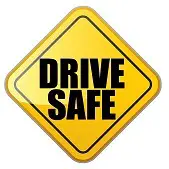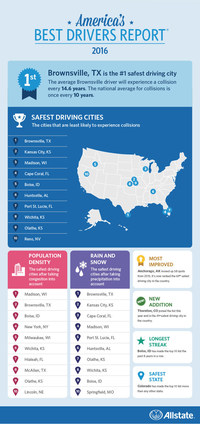Safest Cities for Drivers As Deadliest Day on the Road, Looms Closely
 |
 |
Based on Allstate Insurance Company claims data, the 2016 report measures vehicle collision frequency in America's 200 largest cities to determine which cities have the safest drivers. The average driver in Brownsville, Texas, experiences an auto collision every 14.6 years, which is 31.4 percent less often than the national average of every 10 years.
"With millions of drivers expected to hit the roads nationwide during the July Fourth weekend, our report demonstrates the importance of always putting safety first," said Glenn Shapiro, executive vice president of claims, Allstate. "The Best Drivers Report spotlights America's safest cities as we continue to heighten awareness around increasing roadway collisions that have unfortunate consequences, such as rising fatalities and potentially higher insurance costs."
National safety experts say drivers are now spending more time on the road and suffering more fatal collisions than recent years. The U.S. Department of Transportation says that from March 2015 to February 2016 Americans drove 3.15 trillion miles, an increase of more than 3 percent over the previous 12 months and the largest year-to-year increase in over two decades.ii According to the National Safety Council, more than 38,000 roadway fatalities occurred last year, the highest count since 2008iii.
Preventable human factors, like drunk, distracted or drowsy driving; speeding; and failure to use safety features contribute to 94 percent of car crashes.iv IIHS says intoxication is a significant factor in Fourth of July crash fatalities, with 42 percent between 2010 and 2014 involving at least one driver with a blood-alcohol concentration over the legal driving limit of .08v.
"While July Fourth is consistently the deadliest day on the road, the toll of crash deaths goes on every day, all year long," said Adrian Lund, president, IIHS. "If everyone buckles up, avoids distractions, obeys the speed limit and doesn't drink and drive, we can make July Fourth and every day on the road a lot safer."
Each year, Allstate commends the cities that have the safest drivers on the report. The following are the top 10 safest driving cities, according to Allstate's 2016 America's Best Drivers Report:
|
City & Overall Ranking |
Collision Likelihood Compared to |
Average Years Between (National Average: 10) |
|
1. Brownsville, Texas |
31.4% less likely |
14.6 |
|
2. Kansas City, Kan. |
26.3% less likely |
13.6 |
|
3. Madison, Wis. |
24.7% less likely |
13.3 |
|
4. Cape Coral, Fla. |
22.3% less likely |
12.9 |
|
5. Boise, Idaho |
22.1% less likely |
12.8 |
|
6. Huntsville, Ala. |
21.4% less likely |
12.7 |
|
7. Port Saint Lucie, Fla. |
20.1% less likely |
12.5 |
|
8. Wichita, Kan. |
19.7% less likely |
12.5 |
|
9. Olathe, Kan. |
19.6% less likely |
12.4 |
|
10. Reno, Nev. |
18.3% less likely |
12.2 |
Visit www.allstate.com/BestDriversReport for an interactive map showing this year's findings and for historical collision-frequency rankings from the past 11 years.
Allstate's America's Best Drivers Report® is the result of an in-depth examination of company claims data, to determine the likelihood drivers in America's 200 largest cities will experience a vehicle collision compared to the national average. This year, Allstate actuaries analyzed property damage claims reported during the two-year period of January 2013 to December 2014. A weighted average of the two-year numbers determines the annual percentages.
The report defines a collision as any auto crash resulting in a property damage claim. Allstate's auto policies represent nearly 10 percent of all U.S. auto policies, making this report a realistic snapshot of what's happening on America's roadways.
For the second straight year, the report also provides insight into braking habits in more than 100 cities across the country, using hard-braking data culled from Allstate's Drivewise® offering, an innovative technology that enables consumers to monitor their driving habits to improve safety and gain rewards on their insurance.
A hard-braking event is defined as slowing down eight miles per hour or more over a one-second period. Allstate found a correlation between hard braking and collision frequency. Cities with higher collision frequency also recorded more hard-braking events.
Nationally, on average, a driver will experience 19 hard-braking events for every 1,000 miles driven. The following are the cities with drivers who experience the fewest hard-braking events per 1,000 miles driven:
|
Drivewise® Hard-Braking Events |
|
|
Madison, Wis. |
9.0 |
|
Anchorage, Alaska |
9.3 |
|
Honolulu, Hawaii |
10.1 |
|
Des Moines, Iowa |
10.5 |
|
Wichita, Kan. |
11.1 |
|
Boise, Idaho |
11.6 |
|
Lincoln, Neb. |
11.7 |
|
Kansas City, Kan. |
12.0 |
|
Chesapeake, Va. |
12.2 |
|
Jackson, Miss. |
12.2 |
Driving tips for cities with high braking activity:
- Leave room between you and other vehicles. Hard-braking collisions can occur when drivers are following other cars too closely, causing a rear-end collision. Try to avoid rear-end collisions by leaving more space and time to react to other vehicles' actions.
- Minimize distractions while driving. Distracted driving is one of the main causes of collisions.vi Common driving distractions include eating, grooming, talking on a cell phone or texting, interacting with other passengers, adjusting navigation devices and playing loud music.
In addition to traditional collision-frequency rankings and hard-braking information, Allstate's 2016 report also shows how the largest 200 cities rank, when factoring in two other challenges drivers face – population density and precipitation:
|
Top 10 Cities When Factoring in Population Density |
|
1. Madison, Wis. |
|
2. Brownsville, Texas |
|
3. Boise, Idaho |
|
4. New York, N.Y. |
|
5. Milwaukee, Wis. |
|
6. Wichita, Kansas |
|
7. Hialeah, Fla. |
|
8. McAllen, Texas |
|
9. Olathe, Kan. |
|
10. Lincoln, Neb. |
Driving tips for densely populated cities:
- Allow plenty of time to reach your destination. Stop-and-go traffic, gridlock, traffic signal stops, pedestrian walkways and events that create traffic detours can add time to your travel.
- Stay alert. Be prepared to frequently stop or slow down for pedestrians, emergency vehicles, delivery trucks, parking cars, taxi cabs and public transportation vehicles such as city buses.
|
Top 10 Cities When Factoring in Precipitation |
|
1. Brownsville, Texas |
|
2. Kansas City, Kan. |
|
3. Cape Coral, Fla. |
|
4. Madison, Wis. |
|
5. Port Saint Lucie, Fla. |
|
6. Huntsville, Ala. |
|
7. Olathe, Kan. |
|
8. Wichita, Kan. |
|
9. Boise, Idaho |
|
10. Springfield, Mo. |
Driving tips for cities with high levels of precipitation:
- Be aware of road conditions. Ice, snow, fog, rain – all of these weather conditions require extra caution and slower speeds. Stopping safely in rain and snow takes longer than in dry conditions.
- Maintain your vehicle to prepare for extreme weather. Headlights and brake lights are critical in low-visibility situations – be sure they are consistently maintained, along with other critical car functions such as brakes and windshield wipers.
For more safe-driving tips, visit The Allstate Blog.
About IIHS
The Insurance Institute for Highway Safety
(IIHS) is an independent, nonprofit scientific and educational organization
dedicated to reducing the losses – deaths, injuries and property damage –
from crashes on the nation's roads. IIHS is wholly supported by auto
insurers and insurance associations.
About Allstate
The Allstate Corporation is the nation's
largest publicly held personal lines insurer, protecting approximately 16
million households from life's uncertainties through auto, home, life and
other insurance offered through its Allstate, Esurance, Encompass and
Answer Financial brand names. Now celebrating its 85th anniversary as an
insurer, Allstate is widely known through the slogan "You're In Good Hands
With Allstate®." Allstate agencies are in virtually every local
community in America. In 2015, The Allstate Foundation, Allstate, its
employees and agency owners gave $36 million
to support local communities.
i The Allstate America's Best Drivers Report® tabulates
property damage frequency of Allstate insured drivers from 2013-2014.The
report analyzes the 200 largest cities from the U.S. Census Bureau's Annual
Estimates of the Population for Incorporated Places over 50,000, measured
for 2014 as of July 1, 2015. In prior years,
neighboring cities that shared zip codes also shared rankings. This only
impacted a minimal number of cities; however, since 2014, the report used
geolocation to increase accuracy and there are no longer shared rankings.
U.S. Census Bureau data was used to obtain the population density factor.
For the precipitation factor, National Oceanic and Atmospheric
Administration (NOAA) data was utilized. Allstate Drivewise® data is based
on Allstate customers voluntarily enrolled in the telematics program from
2010-2015. A number of cities from the full 200 Best Drivers rankings are
excluded in the Drivewise data due to the limited measurable data
available, or because Drivewise was not available (California, North
Carolina, South Carolina and Texas). The Allstate Best Drivers Report is
produced solely to boost the country's discussion about safe driving and to
increase awareness of the importance of being safe and attentive behind the
wheel. The report is not used to determine auto insurance rates.
ii 2016, U.S. Department of Transportation, Federal Highway
Administration,
http://www.fhwa.dot.gov/policyinformation/travel_monitoring/16febtvt/page2.cfm
iii 2016, National Safety Council Motor Vehicle
Fatality Estimate,
http://www.nsc.org/Connect/NSCNewsReleases/Lists/Posts/Post.aspx?ID=103&var=hp4
iv 2016, National Highway Traffic Safety
Administration,
http://www.nhtsa.gov/About+NHTSA/Press+Releases/nhtsa-sees-roadway-deaths-increasing-02052016
v Insurance Institute for Highway
Safety
vi National Highway Traffic Safety
Administration, www.distraction.gov
America's Best Drivers Report(R) - full 200-city ranking - http://origin-qps.onstreammedia.com/origin/multivu_archive/ENR/2016-Best-Drivers-Report.pdf


